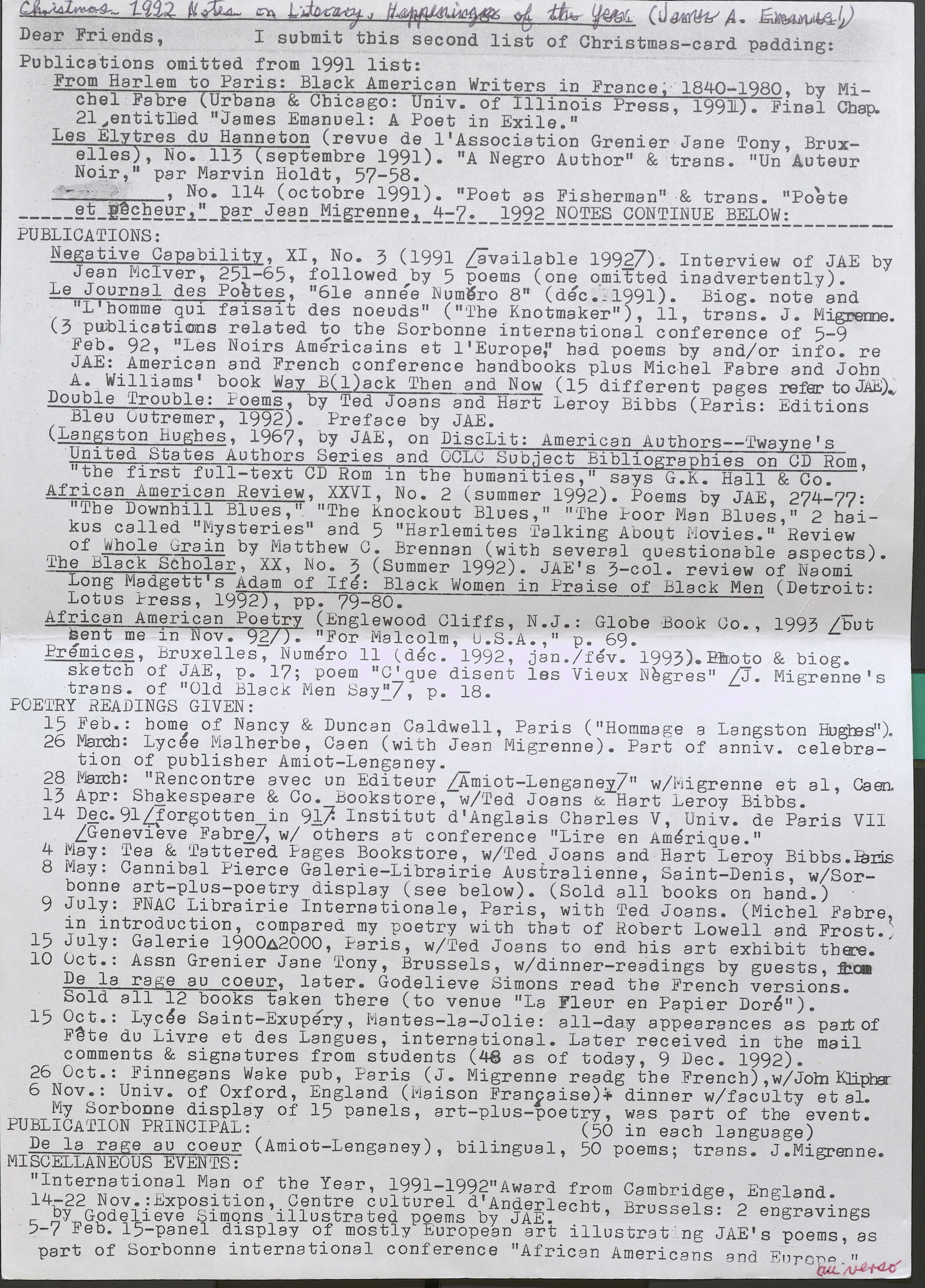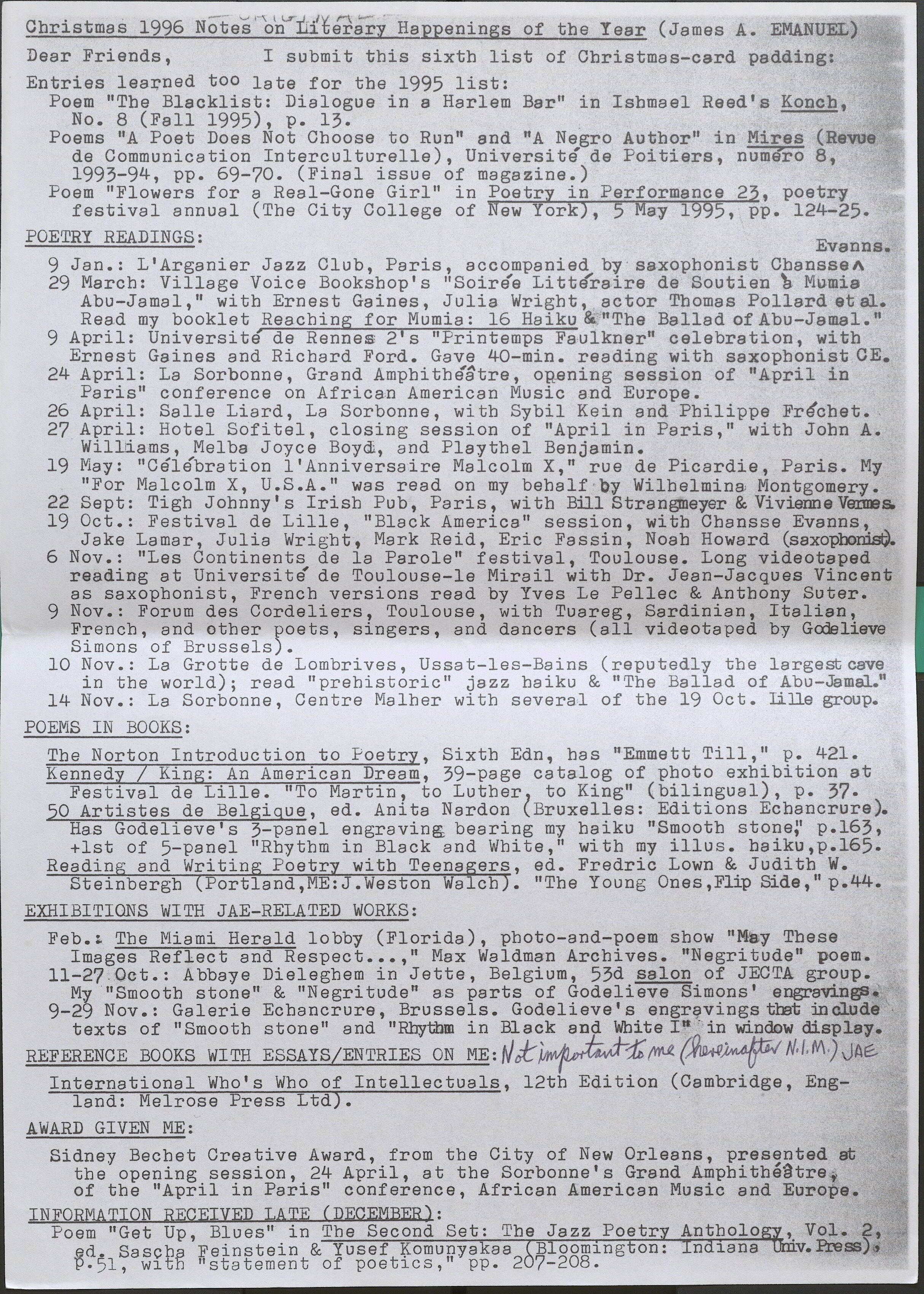Analyze Given Data Source
In my analysis of James A. Emanuel’s “literary happenings” documented in his “Christmas Notes” between 1991 and 2006, I focus on his most productive years. I identify patterns in activity types as well as frequencies of publications and collaborations. I aim to understand how Emanuel’s creative labor unfolded across his relationships overtime. This approach allows me to interpret what productivity means in his “Christmas Notes.” Rather than pursue a year-by-year analysis, I use select years to illustrate broader trends across the notes.
Emanuel’s most productive year is 1992 followed by 1996. In 1992, Emanuel had twenty-nine total activities followed by twenty-five activities in 1996. These activities are happenings based on titles, events, and translations. Nearly half of these activities are poetry readings that were connected to publications. However, many activities are engagements with the following five collaborators: Jean Migrenne, Ted Joans, Hart Leroy Bibbs, Michel Fabre, and Godelieve Simons (“Christmas 1992 Notes”). The top collaborator of 1992 is Jean Migrenne, Emanuel’s translator, with six activities. Among the six activities is De la rage au Coeur, an English and French anthology of Emanuel’s poetry translated by Migrenne. Emanuel also collaborated with Ted Joans and Hart Leroy Bibbs on five and three occasions, respectively. These collaborations were associated with the publication Double Trouble: Poems, written by Joans and Hart with a Preface by Emanuel. Joans also had two additional poetry readings with Emanuel; one reading was at the closing of Joans’s art exhibition in Paris. The other reading was in collaboration with Michel Fabre, who introduced the poets and compared Emanuel’s poetry to “Robert Lowell and Frost”. However, there are two additional activities with Fabre. One was his chapter “James Emanuel: A Poet in Exile” published in From Harlem to Paris: Black American Writers in France, 1840-1980. The other collaboration was his references to Emanuel in his book Way B(l)ack Then and Now that was co-written with John A. Williams. Lastly, the artist Godelieve Simons had two collaborative activities with Emanuel: her engravings of Emanuel’s poems were featured in an exhibition in Brussels, and the pair did a dinner-reading in Brussels in which she read French versions of the book De la rage au Coeur.

Figure 1. Christmas 1992 Notes on Literary Happenings.
By comparison, in 1996, the types of repetition across Emanuel’s twenty-five activities are at times less specific. The first repeating event is “Poetry Readings,” which is designated when Emanuel has a poetry reading but does not write what he read or the name of the reading (“Christmas 1996 Notes”). There are four generic “Poetry Readings.” Based on his collaborators and the locations, these events are likely open mic sessions in which Emanuel performed his jazz haiku. The second event is “April in Paris Conference on African American Music and Europe;” Emanuel performed twice at this event. Also, in 1996, there are two translations: one of Emanuel’s poems “To Martin to Luther to King” that was included in the Kennedy/ King: An American Dream photo-exhibition catalogue at the Festival Lille; the other translation was read by Yves Le Pellec and Anthony Suter at “Les Continents de la Parole Festival” in Toulouse—the poems are not noted. Also, the poems “Smooth stone,” “Rhythm in Black and White” and “Negritude” are featured in exhibits; “Smooth stone” is featured on four occasions and “Rhythm in Black and White” and “Negritude” are featured three times each. Lastly, “The Ballad of Abu-Jamal” is featured two times at poetry readings.

Figure 2. Christmas 1996 Notes on Literary Happenings.
Among these poems reoccurring in 1996 is “The Ballad of Abu-Jamal,” which stands out for how it showcases Emanuel’s collaborations in the areas of translation, activism, and visual art. “The Ballad of Abu-Jamal” first appears in Emanuel’s 1996 “Christmas Notes.” The poem is a translation by Jean Migrenne of Emanuel’s collection “Reaching for Mumia: 16 Haiku” that was first mentioned in the 1995 “Christmas Notes.” This collection of haikus that Emanuel calls a “booklet” was created “to raise funds for the defense of Mumia Abu-Jamal,” the journalist and political activist turned death-row prisoner, for the murder of Daniel Faulkner, a Philadelphia police officer (“Christmas 1995 Notes”). The activities to support this cause such as readings, fundraisers, and soirees was led by Julia Wright, the novelist Richard Wright’s daughter. The activities related to these events connected Emanuel with artists and activists in France. In 1996, “The Ballad of Abu-Jamal” was read at a literary soiree at Village Voice Bookshop in Paris and in the natural cavern La Grotte de Lombrives in France.
Figure 3. This interactive map shows the global reach of James A. Emanuel’s literary and scholarly activities. Each dot represents a location where he participated in events, gave readings, or collaborated with others. Click a collaborator’s name on the left (next to a colored square) to see where they worked with Emanuel. Some names appear more than once because those collaborations involved different people. To adjust the map, hover over the visualization and (+) and (-) icons will appear on the top-left of the map that enables zooming in and out.
The overview of Emauel collaborations in 1992 and 1996 provides insight into collaborations across the “Christmas Notes.” Emanuel was collaborating with artists, translators, scholars, and activists. The analysis shows that most of his collaborations happened in Western Europe with a concentration in France and Belgium. Emanuel’s top five collaborators across the dataset are Godelieve Simons, Jean Migrenne, Chansse Evans, Ted Joans, and Jake Lamar. Simons and Emanuel had sixty-three collaborations; most of their collaborations are located in Belgium and France with other collaborations happening in the United Kingdom, U.S.A., Brazil, Italy, and Tunisia. With Migrenne, Emanuel collaborated twenty-three times, and these collaborations are in Belgium and France exclusively. However, Emanuel’s eighteen collaborations with Evans are outliers. Evans and Emanuel traveled twice on United States-sponsored tours; on each tour, they went to five countries, spanning the Middle East, North Africa and West Africa. The duo also had performances in Germany, but the majority of their performances were in France. Similar in scope, Emanuel had seven collaborations with Joans and six collaborations with Lamar, and most of these took place in France except for two readings with Lamar in Lille.
Figure 4. This line graph shows James A. Emanuel’s activities and collaborations over time. The Green line shows the count of Emanuel's activities, and the Red line shows the counts of Emanuel's collaborators. The Green line shows a general downward trend in total activities. The Red line shows peaks and valleys of Emanuel's collaborators with a general increase of collaborators in the 2000s. Click on the green or red lines to see a list of collaborators for that year appear below the words "Activity Year" on the X-axis.
These snapshots of 1992 and 1996 serve as representative of a larger pattern in Emanuel’s “Christmas Notes”: collaboration is a central aspect of his creative and public activity. Emanuel’s activities tend to rise and fall in correlation with collaboration. However, there is one exception: 1999. In this year, Emanuel’s total activities declined by four, but his total collaborations increased by ten. Keeping in mind, this does not mean that all Emanuel’s events are collaborations; this means that Emanuel’s number of collaborators exceed the number of events. There are two examples that explain this. In Rome, March of 1999, Emanuel performed his jazz haiku with musical accompaniment provided by Davide Grottelli, Riccardo Duranti, and Anamaria Crowe (“Christmas 1999 Notes”). The same month, in Münster, Germany he performed his jazz-blues-gospel-haiku with Chansse Evans, Fritz Gysin, and Sieghild Bogumil. However, the leading collaborator across titles is Emanuel’s work with Godelieve Simons. In 1999, their work “Variations sur un rythme noir” was exhibited in France and Brussels. Simons visual art of Emanuel’s poem “Deadly James” was presented in Santa Catarina, Brazil at the fifty years of the Universal Declaration of Human Rights. Simons also translated Emanuel’s book JAZZ from the Haiku King. All of these collaborations are driven by Emanuel’s haikus in part due to the recent publication of JAZZ. Emanuel read his haikus with music accompaniment and on occasions with a small band; he also had several collaborations with Simons who engraved many of his haikus. 1999 was the only year that Emanuel’s number of collaborators exceeded his total activities.
Works Cited
Emanuel, James A. “Christmas 1992 Notes on Literary Happenings.” MS Box 14, Folder 7, “Biographical Materials, 1987–2003, 2007, Undated,” James A. Emanuel papers, 1922–2018. Library of Congress. Washington, D.C.
Emanuel, James A. “Christmas 1996 Notes on Literary Happenings.” MS Box 14, Folder 7, “Biographical Materials, 1987–2003, 2007, Undated,” James A. Emanuel papers, 1922–2018. Library of Congress. Washington, D.C.
Emanuel, James A. “Christmas 1995 Notes on Literary Happenings.” MS Box 14, Folder 7, “Biographical Materials, 1987–2003, 2007, Undated,” James A. Emanuel papers, 1922–2018. Library of Congress. Washington, D.C.
Emanuel, James A. “Christmas 1996 Notes on Literary Happenings.” MS Box 14, Folder 7, “Biographical Materials, 1987–2003, 2007, Undated,” James A. Emanuel papers, 1922–2018. Library of Congress. Washington, D.C.